Thunder Ray is an arcade-style boxing videogame that uses pattern recognition and timing challenges to create boxing matches that are equal parts action and puzzle. I play as Thunder Ray, a champion boxer who has become bored with the sport. There seems to be no competitor on Earth capable of challenging him. After easily knocking out another upstart looking to make his name, Ray is abducted by aliens and taken to an intergalactic boxing tournament filled with other champion combatants from around the galaxy. He gets what he wished for, but in the worst possible way: These matches are to the death. Ray must continue his winning streak against eight unique opponents or suffer a murderous retirement.
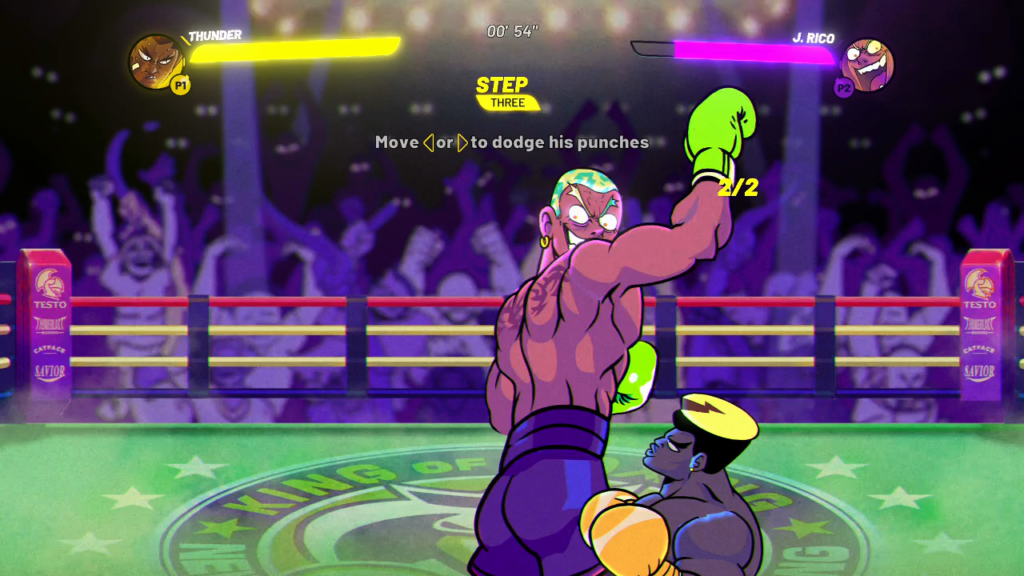
A brief tutorial, set against a normal human opponent and before Ray’s abduction, introduces me to the mechanics of boxing in Thunder Ray. My most persistent and challenging task is ensuring Ray avoids his opponent’s oncoming attacks. He can dodge to the left or right, duck, or brace himself against the coming blow. Only one of the four options is effective against each attack. Much of my learning curve is recognizing which attack is coming and inputting the correct defensive maneuver before it connects. It often takes several attempts to learn which maneuver is effective and execute it with the correct timing. Sometimes it takes many, many, many attempts. This learning process is where Thunder Ray derives most of its longevity. Stumbling once through each fight may take a few hours. Mastering all of them can take dozens.
To make the learning process easier, Ray’s opponents attack in mostly predictable patterns. The third match is against kickboxing cyborg Cobra Millennium. I struggle against them until I recognize they always begin the fight with a low kick that may be dodged if Ray leans to the right, then a high sweep several seconds later which Ray can duck under. After another window of a few seconds, they finish with a second high sweep followed immediately by another low kick, which Ray can avoid by ducking then immediately leaning to the left. I lead Ray into several hopeless losses against Cobra before I recognize this pattern.
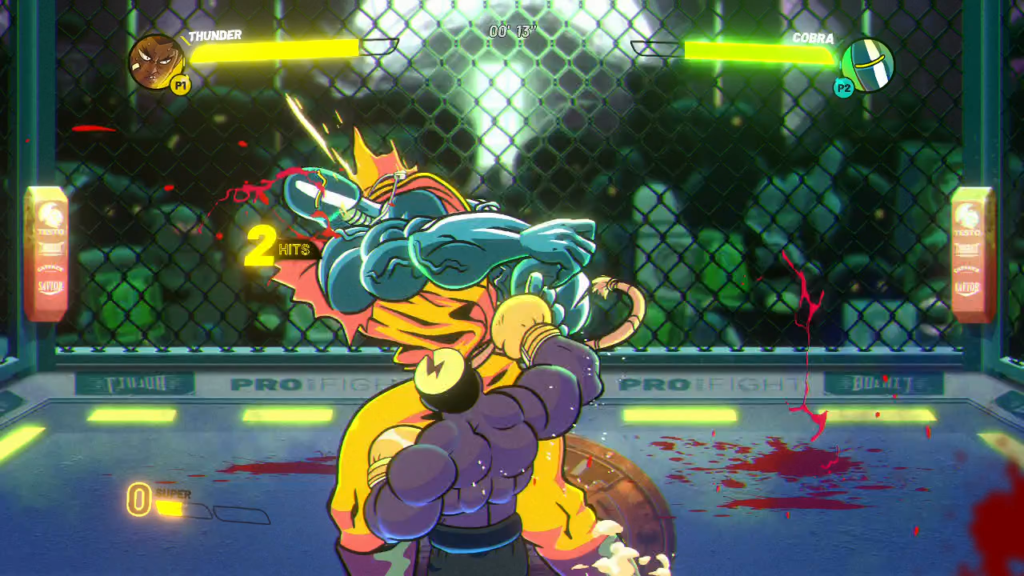
Between an opponent’s attacks, Ray must counterattack with his own punches. I direct his fists using the controller’s four face buttons, which are arranged with clarion logic. The left and right buttons in each row control his left and right fists respectively. The upper row sends punches high, often into the opponent’s face. The lower row sends the punches low, into their abdomen. Like dodging, there are specific patterns of punches which are effective against different opponents and in different situations. Also like dodging, discovering these patterns is a matter of trial and error.
Matches unfold with Ray and his opponent taking turns trading blows. When Ray’s punches connect, its target loses a portion of their stamina meter. Emptying the stamina meter completely makes them collapse to the ring’s floor. When they rise again, they enter a new phase where they introduce new attacks and new patterns. Enduring this pattern is made easier with Ray’s super attacks, which charge with each punch he lands. A fully charged super attack devastates the opponent’s stamina. If Ray knocks them out three times through three phases of combat, then he is declared the winner and progresses to the next match.
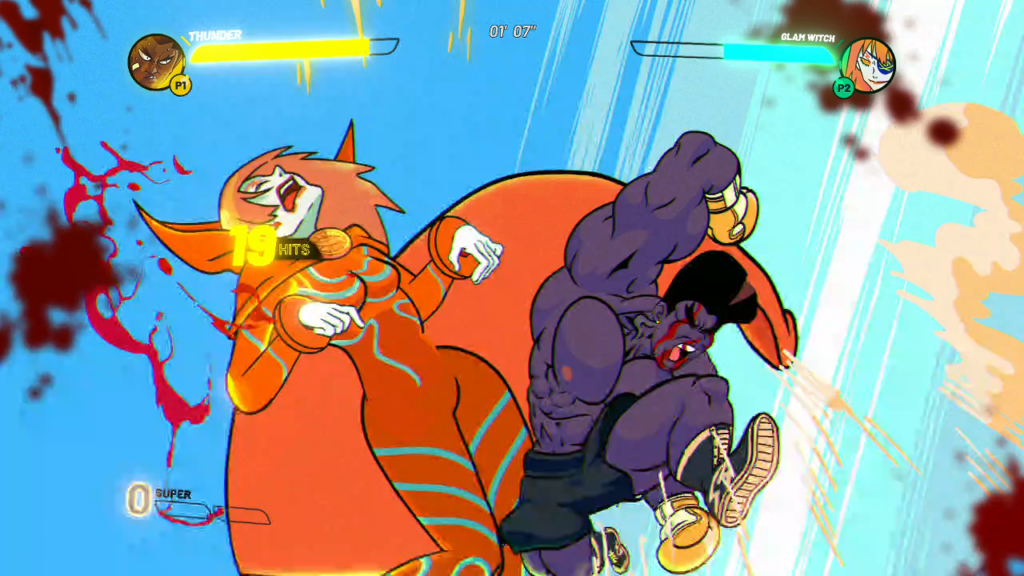
The same idea holds true for Ray. When he runs out of stamina, he falls to the mat while the referee starts counting. I must mash buttons to encourage him to rise. If Ray is not back on his feet before the referee reaches ten, he loses the match. Not once do I struggle to make this happen. I never feel a danger that Ray or his opponents will not stand up before they time out. Every match is carefully scripted and always ends after either competitor touches the mat for the third time. If I want Ray to lose by time out, I have to sit and let it happen. Every time we lose, it’s because Ray has been punched out three times, and we must try the fight again from the start.
Thunder Ray is undergirded by these solid boxing mechanics. What elevates them is its standout attribute: Its character designs and their unique animations.
Every fight is awash in neon colors, especially teal and purple. Ray’s golden gloves and the yellow lightning bolt stylized into his box cut afro stand out against this color palette, popping against his otherwise plain and muscular appearance. Making Ray look like an ordinary boxer feels like a conscious choice, emphasizing his humanity and his ordinariness. Ray might be an elite athlete by human standards, but thrust into an intergalactic competition, he becomes the underdog and the everyman.
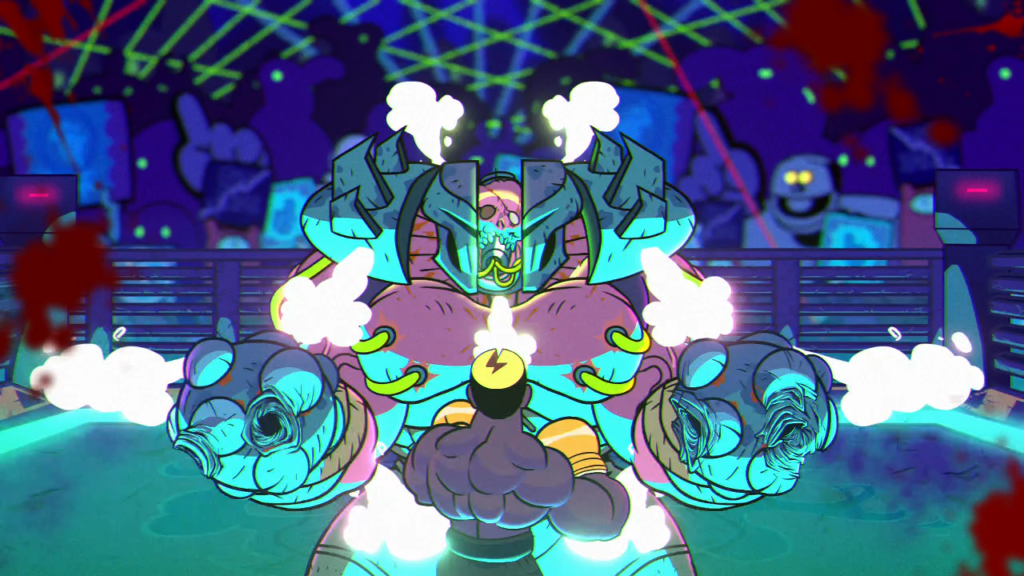
Contrasting with Ray’s human physique are his fantastic and alien opponents. His first alien opponent is Back Breaker, a hulking cyborg with bulging veins pulsing along their pink skin, pumping chemicals into the cybernetic implants bonded to their fists and head. As Ray lands blows, their implants shatter, revealing the tortured skull underneath their mask. Another opponent is Glam Witch, a physically unimposing woman who nevertheless puts up great resistance thanks to her magic. She reclines on air in a protective bubble, casual and perhaps bored, waving her arms and flicking her fingers to send spells at Ray. The effects which herald these spells are subtle before exploding into the riotous and spectacular. It takes all my concentration to ensure Ray avoids her spells while he pounds away at the bubble.
With as detailed and interesting as these character designs are, I am disappointed to recognize where several of them come from. Back Breaker is transparently a take on Batman supervillain Bane, right down to being named after Bane’s most famous contribution to Batman’s mythology. Evil Rico is so obviously Piccolo from Dragon Ball that it feels like he’s been copied with tracing paper. Recognizing the “inspirations” for these characters makes me suspect that all of Thunder Ray’s diverse opponents are not wholly original. I only lack the broad knowledge to recognize them all. Despite these misgiving, I am still impressed by the character designs. Not a single one of Ray’s opponents feels similar to any other.
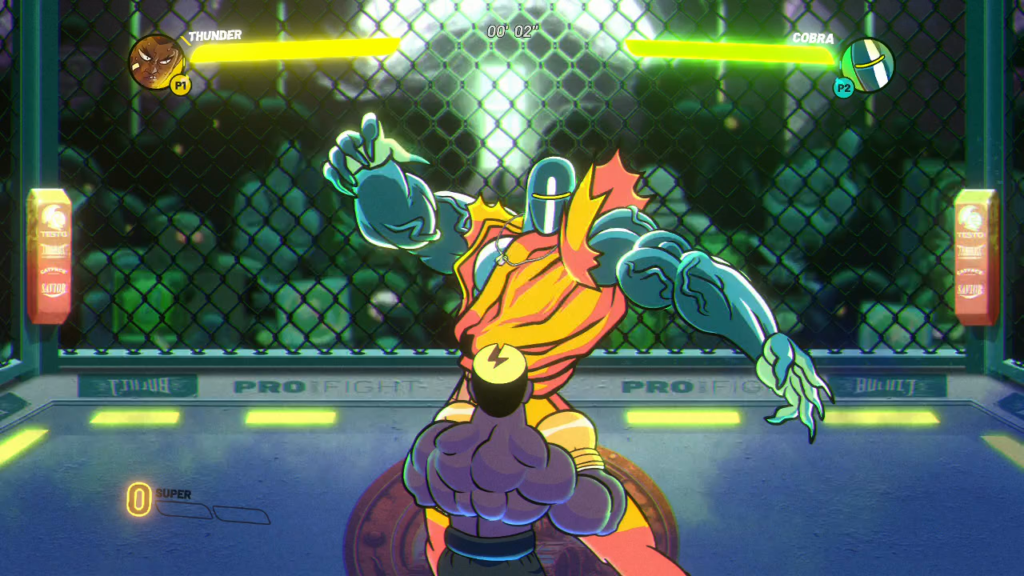
These designs serve a greater purpose than looking great in promotional images and trailers. The way they are animated is integral to my understanding of which move Ray’s opponent is about to make and how I must respond. I know that in his first phase, Cobra Millennium will always open with a low kick to the left, then a high chop from the right, then a second high chop followed immediately by a low kick to the right. I recognize these attacks by looking at Cobra’s animated “tells.” When he twists to the right, a low kick to the left is on the way. When he raises either of his clawed hands, a high sweeping chop is coming. When he twists to his left, a low kick to the right is on the way.
It takes much practice to recognize these tells and correctly respond. Often I have just a fraction of a second to make a choice. Making the wrong one means Ray takes a punishing blow and comes one step closer to losing his life.
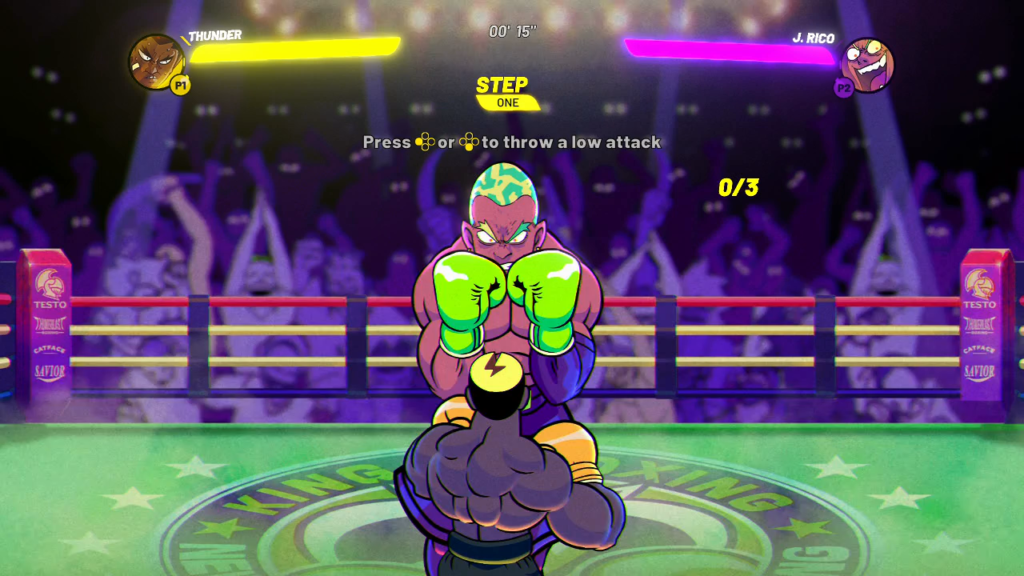
As lavish as each opponent’s animations are, I still feel there are places where they could have more detail. The core strategy for defeating each opponent is to dodge their attacks, then respond with Ray’s own attacks. While there are tells for when an opponent will attack, there is no tell for when they will take damage. When their attack animations are finished, they move back to a neutral pose, which usually consists of sneering at and taunting Ray. Faced with these neutral poses, it’s not clear which hand Ray should open with or whether to aim low or high. The result is I never feel like it is time to attack, and when I begin pressing buttons, the opponent’s dodges and blocks can feel frustratingly random and arbitrary.
Even against the earliest, easiest opponents, punching never feels good. Ray seems to flail randomly. It’s not clear when he should start punching, or when he should finish. Sometimes an opponent will block or dodge a punch straight away. Sometimes Ray can get several punches in before his attacks become ineffective. It’s easy for me to fall into the trap of punching randomly, but opponents are designed to punish Ray for this behavior. If too many punches are thrown, the recognizable patterns I have spent so much time learning disappear and I must guide Ray through an onslaught of random attacks. This never ends well.
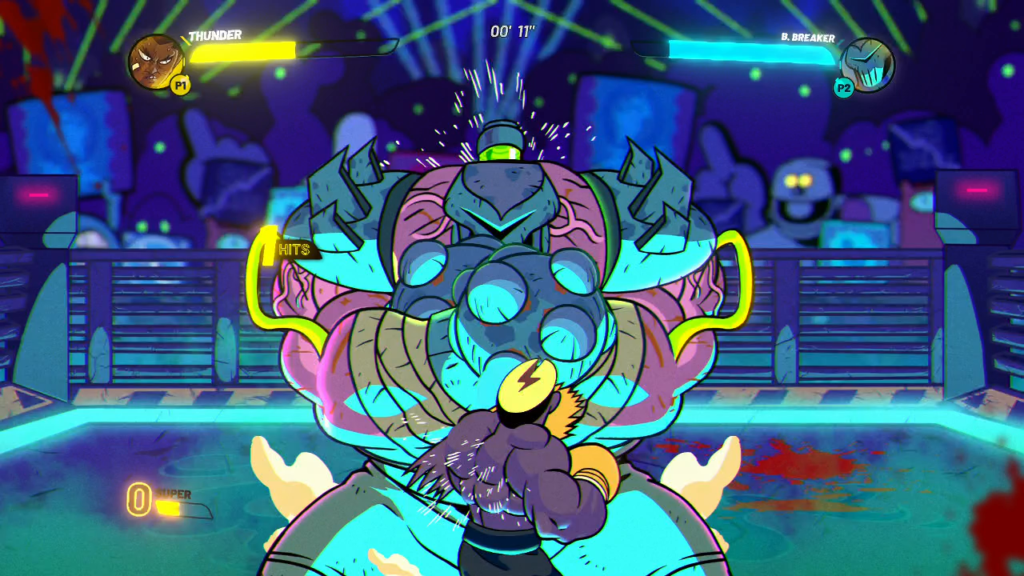
The solution I find is to dodge a set of attacks, then respond with three or four punches which may or may not connect. It’s a system that works in the totality of a match, but in the short run it makes Ray feel weak and unskilled, a far cry from the Champion of Earth he is meant to be.
At least, it works for a little while. Ray’s fifth opponent is Lord Worw, a vampiric creature wearing a cape who appears to be a moving silhouette except for his Mickey Mouse-esque white gloves and a hungry smile filled with pointed teeth. His gimmick is he literally brings a knife to a fist fight. Worw’s animation is stellar, passing his knife smoothly from hand-to-hand before suddenly stabbing from one side of the screen to the other. I can never seem to get the timing against Worw’s basic attacks right, so I decide to drop Thunder Ray to its lowest difficulty.
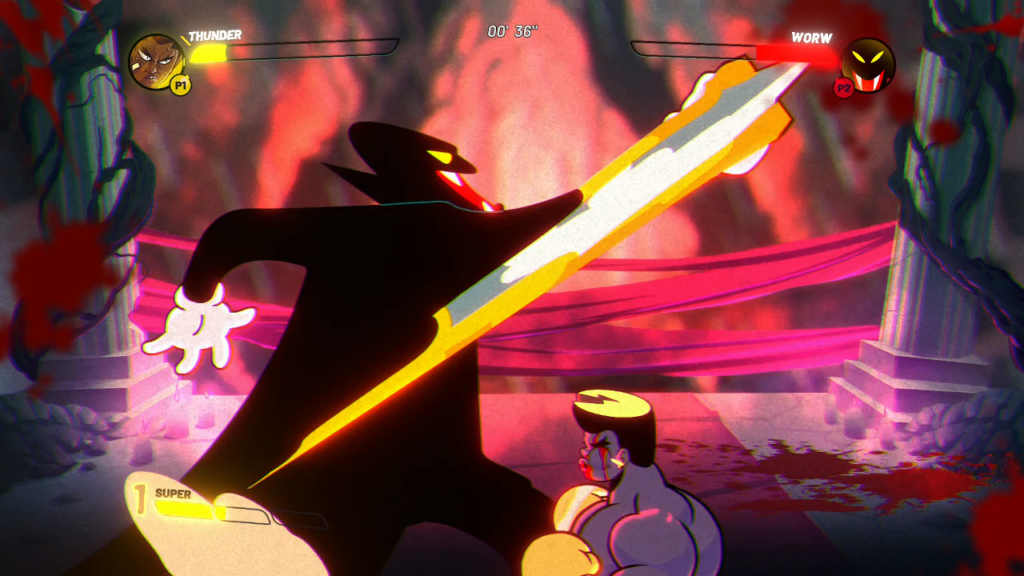
There are three difficulties total which may be selected from a menu before each fight: Rookie, Contender, and Beast. There seems to be no functional difference between the difficulty levels other than the damage Ray and his opponents take; on Rookie, Ray takes little damage while dealing a lot, while on Beast the opposite is true. After switching to Rookie difficulty for Worw, I find myself no more successful at dodging the knife lunges, but am able to keep up with the damage he deals. Worw goes down three times long before Ray does.
Maybe I gave up too fast, but I felt truly helpless against Worw on the Contender difficulty. He didn’t make me feel challenged or engaged. He made me feel demoralized. After a relatively easy win on Rookie, the remaining opponents also went down in one or two attempts. I am dismayed to discover that Thunder Ray is too difficult on its middle Contender difficulty and too easy on Rookie. I cry out for a satisfying middleground between the two. Easily defeating the final opponent on Rookie leaves me feeling sour about the whole experience, especially since there seems to be a secret boss which cannot be fought on Rookie. I try returning to Worw on Contender, but find no more success. So I give up.
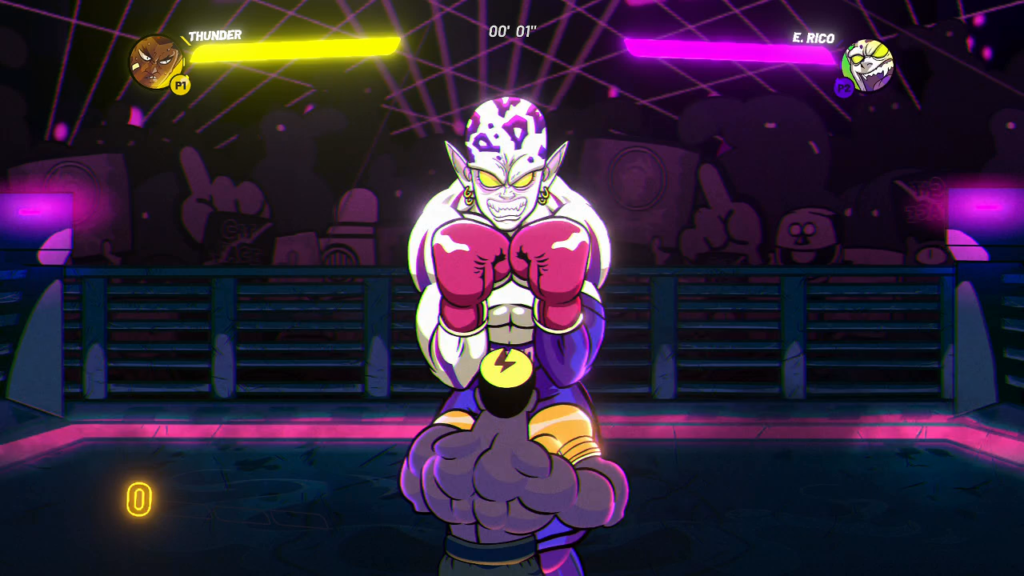
There’s the essence of a great boxing videogame in Thunder Ray. Its underlying mechanics are solid. The strong, if unoriginal, character designs and excellent animations do a great job communicating what Ray needs to do to navigate through his opponents’ attack patterns. Knowing what I need to do is not the same thing as doing it and slowly learning each opponent’s unique patterns and timing is deeply gratifying. What feels missing is feedback for Ray’s own punches. I never know if his attacks are effective because his opponents never reveal their vulnerabilities through their animations. When their attacks become too fast for my poor reflexes, I drop the difficulty and fights switch from too hard to too easy. Players interested in testing the limits of their frustration may find conquering Thunder Ray’s battles rewarding. I started out there, but grew disillusioned by its weaknesses.